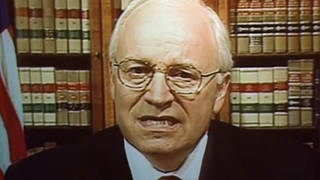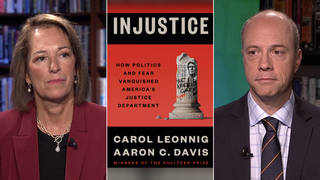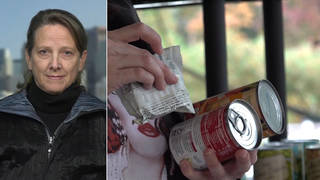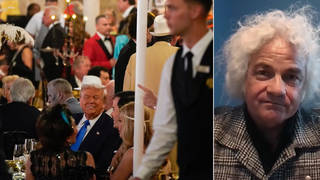
Guests
- David Rothenbergfounder of the Fortune Society and a member of the Attica Observers Committee that came into Attica prison in 1971 during the prisoner uprising.
- Michael Hulldirector of the documentary Betrayal at Attica.
On the 50th anniversary of the Attica prison uprising, we look at the cover-up that began immediately after New York state police stormed the prison and opened fire, killing 29 inmates and 10 hostages. David Rothenberg, a member of the Attica Observers Committee brought into Attica to help negotiate a peaceful resolution, says the prison was “an institution that only knew how to run by punishment,” laying the groundwork for the uprising. “The event itself is almost a microscopic view of the failure of our criminal justice system and our prison system,” says Rothenberg. We also speak with filmmaker Michael Hull, director of the new HBO Max documentary “Betrayal at Attica,” about how the film includes never-before-seen evidence from the archive of Attica Brothers defense attorney Elizabeth Fink, including deposition interviews from the 1974 civil suit she successfully led on their behalf against the state of New York. “The state police conducted the retaking of the prison. They also conducted the investigation of themselves. So they started destroying and obfuscating evidence on September 13, 1971,” says Hull.
Transcript
AMY GOODMAN: This is Democracy Now!, democracynow.org. I’m Amy Goodman.
We’re spending the hour marking the 50th anniversary of the deadliest prison uprising in the history of the United States, speaking with a formerly incarcerated survivor who was shot several times by state troopers. In a minute, we’ll be joined by one of the negotiators, who were brought in by the prisoners, and the filmmaker who helped uncover the evidence of what really happened.
A warning again that today’s show includes graphic, painful descriptions and images. This clip from the new HBO Max documentary Betrayal at Attica shows how misinformation spread about how the hostages who were killed during the Attica uprising actually died. This is New York prison system spokesman Gerald Houlihan saying that hostages had their throat slashed, and then the county medical examiner, Dr. John Edland, who contradicts him. But first we hear from attorneys Liz Fink and Bill Kunstler.
WILLIAM KUNSTLER: If they had only waited ’til today, there would be now 40 or 41 people still alive in this universe of ours. They would not wait, because these men were expendable. Guards, prisoners had no meaning in the scheme of things of our white, totalitarian world.
REPORTER: How did they kill the hostages?
GERALD HOULIHAN: Well, several had their throats slashed. I don’t have all the details on it. I understand one had a chest wound that he died from. And I don’t have all of those details.
ELIZABETH FINK: When you read the front page of The New York Times, it’s a scream. It is. I mean, they have them fighting hand by hand in the blocks for four hours.
REPORTER: The press accepted Houlihan’s report of slashed throats, but the next day, county medical examiner John Edland announced the truth.
DR. JOHN EDLAND: The first eight autopsies were on the cases identified to us as hostages. All eight cases died of gunshot wounds.
ELIZABETH FINK: He was this conservative Republican, and he was a doctor. So, you know, they brought all these bodies to him. And he says, “Oh, these were all shot. Right? You know, nobody’s — what are you talking about?”
DR. JOHN EDLAND: There was no evidence of slashed throats. There was one single cut in the back of one of the necks.
ELIZABETH FINK: And they totally attacked him, and destroyed him, actually.
AMY GOODMAN: And this is another clip from Betrayal at Attica. On the night of September 13, 1971, 50 years ago today, New York Governor Nelson Rockefeller called President Nixon to update him on the retaking of Attica. Their conversation was recorded on the same machines that brought down Nixon’s corrupt administration three years later. This is part of their call.
PRESIDENT RICHARD NIXON: I know you’ve had a hard day, but I want you to know that I just back you to the hilt for the courage you showed and the judgment in not granting amnesty. It was right, and I don’t care what the hell the papers or anybody else says. I don’t care what they say. I think that you had to do it that way, because if you would have granted amnesty in this case, it would have meant that you would have had prisons in an uproar all over this country.
GOV. NELSON ROCKEFELLER: That’s right, absolutely.
PRESIDENT RICHARD NIXON: And you did the right thing. It’s a tragedy that these poor fellows were shot, but I just want you to know that’s my view, and I’ve told the troops around here they’re to back that right to the hilt.
GOV. NELSON ROCKEFELLER: Well, aren’t you great, Mr. President? I only called you because I wanted to alert you that we were going in.
PRESIDENT RICHARD NIXON: Right.
GOV. NELSON ROCKEFELLER: And when we went in, we couldn’t tell whether all 39 hostages would be killed, and maybe two or three hundred prisoners.
PRESIDENT RICHARD NIXON: Yeah.
GOV. NELSON ROCKEFELLER: And that’s a pretty big —
PRESIDENT RICHARD NIXON: Boy.
GOV. NELSON ROCKEFELLER: You know.
PRESIDENT RICHARD NIXON: Yeah.
GOV. NELSON ROCKEFELLER: They did a fabulous job
PRESIDENT RICHARD NIXON: How many? I just — I only got the report this morning. What is the latest report? How many people?
GOV. NELSON ROCKEFELLER: Seven hostages were killed.
PRESIDENT RICHARD NIXON: Seven hostages were killed.
GOV. NELSON ROCKEFELLER: Yeah. These were the guards.
PRESIDENT RICHARD NIXON: Those are guards.
GOV. NELSON ROCKEFELLER: It appears now, Mr. President, as though quite a few of those were killed prior to this — in other words, that they had been dead.
PRESIDENT RICHARD NIXON: Uh-huh. You can — you can prove that, can’t you? I mean —
GOV. NELSON ROCKEFELLER: Well, this is the hospital.
PRESIDENT RICHARD NIXON: The hospital can prove that.
GOV. NELSON ROCKEFELLER: Oh yeah.
PRESIDENT RICHARD NIXON: They can — they can find out how long a guy is dead.
GOV. NELSON ROCKEFELLER: That’s right. And they’re — it’s a Catholic hospital.
PRESIDENT RICHARD NIXON: Yeah.
GOV. NELSON ROCKEFELLER: So it’s outside of our jurisdiction.
PRESIDENT RICHARD NIXON: Right. Tell me this: Is this a — are these primarily Blacks that you’re dealing with?
GOV. NELSON ROCKEFELLER: Oh yes. This is — the whole thing was led by the Blacks.
PRESIDENT RICHARD NIXON: I’ll be darned. Are all the prisoners that were killed Blacks? Were there any whites?
GOV. NELSON ROCKEFELLER: I haven’t got that report, but I have to —
PRESIDENT RICHARD NIXON: Yeah.
GOV. NELSON ROCKEFELLER: I would say, just offhand, yes.
PRESIDENT RICHARD NIXON: Yeah. Yeah, mm-hmm.
GOV. NELSON ROCKEFELLER: We did it, though, only when they were in the process of murdering the guards or when they were attacking our people as they came in to get the guards.
PRESIDENT RICHARD NIXON: Had to do it.
GOV. NELSON ROCKEFELLER: And, otherwise, we recaptured all the cell blocks and so forth without shooting a shot. And no troopers were wounded. One of them — well, one of them was, in the leg.
PRESIDENT RICHARD NIXON: Mm-hmm, mm-hmm.
GOV. NELSON ROCKEFELLER: But —
PRESIDENT RICHARD NIXON: Only one trooper was wounded. Good.
GOV. NELSON ROCKEFELLER: That’s right.
PRESIDENT RICHARD NIXON: Good, good, good.
GOV. NELSON ROCKEFELLER: It really was a beautiful operation.
AMY GOODMAN: “It really was a beautiful operation,” New York Governor Nelson Rockefeller said on that day. In fact, Nelson Rockefeller would then become vice president under President Ford.
For more, we’re joined by David Rothenberg, a member of the Attica Observers Committee. He was one of 35 people brought into Attica to negotiate on behalf of prisoners. He’s founder of the Fortune Society, which was relatively new at the time of the uprising, that helped people who got out of prison reintegrate into society. Also with us, Michael Hull, director of the new HBO documentary film, Betrayal at Attica, that plays this conversation between President Nixon and then-New York Governor Nelson Rockefeller.
David Rothenberg, your thoughts on what happened and why, when you were negotiating with so many others between the prisoners and the state, Rockefeller decided to simply have the troopers open fire?
DAVID ROTHENBERG: Amy, we were brought in as observers. The inmates were the negotiators as it went along. Some of the observers, like Bill Kunstler and Congressman Badillo and Tom Wicker, were a little more sophisticated than people like myself who were new in this whole arena. And they were giving advice.
But what had happened is, in the takeover — you said earlier that one of the guards had been beaten up, and two of the inmates, in the takeover. And Officer Quinn — during the negotiations, the word came out that Officer Quinn had died. And that changed the whole tone of the negotiations, because amnesty was taken off the table.
The irony of that, for me — and I always say this: I brought nothing to what happened in the yard that day; I was an observer. What I came away with was life-changing, because what the state did is they went in and killed, as we learned, nine of the hostages. They wouldn’t continue the negotiations because one guard had died, but they then killed the hostages.
And, you know, years later, a man named Malcolm Bell, who was hired by the state to investigate all of what was Attica, suddenly had a press conference and said the state’s been lying through the whole time. He wrote a —
AMY GOODMAN: And he was a Republican.
DAVID ROTHENBERG: He was a conservative Republican, wrote a book called The Turkey [Shoot]. And we started communicating, and he was giving us chapter and verse.
But I think one of the most significant things about all of this, beyond just Attica, because “Attica is all of us” has become a motto, is — every time I talk about Attica, there’s always someone that reminds me, “Well, these men had committed serious crimes, and they were dangerous,” etc. The irony in our prison system — and Attica is almost the epitome of it — is that people went in there — having been charged and convicted of serious crimes, they went into an atmosphere that nurtured the very behavior that got them in there. There was nothing in Attica, or in much of the prison system around the country, that gave people an opportunity to confront why they are there and what they could do to lessen the possibility when they go back to the communities.
And Attica was, as Tyrone — and Tyrone should be thanked for continuing to be a voice for those who are no longer here to tell the story — that you don’t go into a place and be given one roll of toilet paper a month and feel disgusting about yourself, when you’re going in with self-negative feelings to begin with. And they do everything in the institution — and when Tyrone talked about those sticks, that they stop and go with, they were called — I can’t say the word, the N-stick. The guards called them the N-sticks. And they nurtured the hostility.
And the other thing was, on the takeover, there was — I know at least one white inmate died, because two people were died — were killed after the takeover because they were targeted. One was Sam Melville, and the other was L.D. Barkley, Barkley because he had been such an — had been on the news coverage when the cameras went in, had been such an articulate spokesperson for the inmate perspective. And Sam Melville was targeted because he had been a political Weatherman and had helped with some of the Black inmates, like Roger Champen and Herbert X. Blyden, to break down the differences. The inmates were kept — as Tyrone pointed out, inmates were always kept apart. That’s how they kept control, pitting white against Black, with Puerto Ricans in the middle.
People like Herbert Blyden and Roger Champen and Sam Melville, Black and white, said, “Together, we’re stronger. We can effect change to improve the conditions, to create opportunities, to have education programs.” That was threatening to an institution that only knew how to run by punishment. And so, Attica, the event itself, is almost a microscopic view of the failure of our criminal justice system and in our prison system.
AMY GOODMAN: And that conversation between President Nixon and then-New York Governor Nelson Rockefeller?
DAVID ROTHENBERG: Well, I’ve always — the Attica Observers Committee met weekly at Bill Kunstler’s house. And one of the things that I’ve clearly come to the conclusion is that Nelson Rockefeller was making choices as he was reconstructing his political image — the Rockefeller drug law, which followed soon after. He wanted to run for president. He was perceived as an Eastern liberal. He was reconstructing — this was calculated.
And so, the decision to send in troops was all part of the plan to begin with. And it was decided, as Herman Badillo told us, that they waited ’til Monday morning because they were afraid there would be the unrest in the ghetto, as they described it, if they went in on Sunday. So they waited ’til Monday morning.
And they could have taken over the institution with the gas, with the mace, and never shot a single bullet. But that was a — Herman Badillo and Tom Wicker were on the phone with Rockefeller on Sunday night imploring. And that’s when Herman said, “There’s always a time to die,” which became the title of Tom Wicker’s book. Wicker was a columnist with the Times. And he and Herman had a lot of sway and power and had access to Rockefeller. And they pleaded with him, “Give us more time to talk.” And the choice was political. It was made in Albany. It wasn’t made — it wasn’t made at Attica at all. It was a political decision.
AMY GOODMAN: I want to bring Michael Hull into the conversation. This new HBO Max documentary, Betrayal at Attica, is horrifying, as you use archival footage, some of it never before known, and also the lies, the cover-up. I mean, you have David mentioning the conservative Republican investigator writing a book, ultimately, about what he found, and that book called The Attica Turkey Shoot: Carnage, Cover-Up, and the Pursuit of Justice, by Malcolm Bell. And, of course, you hear Tyrone talking about — in our last segment, Tyrone Larkins talking about what happened. Why was it so important for you to make this film, Michael?
MICHAEL HULL: I spent a lot of time with Liz Fink. And Liz had preserved this archive. The state of New York has been saying for 50 years that this evidence doesn’t exist, that it was destroyed, whatever the case may be. And the state police conducted the retaking of the prison. They also conducted the investigation of themselves. So they started destroying and obfuscating evidence on September 13th, 1971. And Liz managed to find this evidence, and she used some of it in the civil trials that she was kind of the leader of. And, you know, the state of New York continued to act like this evidence didn’t exist. And the evidence proves exactly what she said all along and, you know, what David and Tyrone have said. They planned this thing, and they did exactly what they planned. They wanted a massacre.
And Liz always felt like it was intended to stop protest in this country. She felt like they were tired of all the protests that had been taking place, and they were not trying to see protest move into the prison space, and they felt like they could murder these men and get away with it. And it was more important to stop this rebellion and make their point than it was even to protect their own employees. You know, it wasn’t just inmates who were murdered. They murdered their own employees. And all of them were citizens of the state of New York. All of them were supposed to be looked after in one way or another by the governor. And he chose to kill them instead.
And so, for them to carry all of this out in such a cynical and manipulative kind of way, and then to just act like it didn’t exist or it never happened, you know, Liz was very offended, you know? And she was an organizer, and she organized me.
AMY GOODMAN: And ultimately won that $12 million settlement for the prisoners. And Frank “Big Black” Smith would also fight for a settlement for the workers, for the prison guards, as well. We have 10 seconds, Michael.
MICHAEL HULL: Liz wanted to make sure that everybody could see this evidence, because she knew that if people could see it, they would never believe the lies of the state of New York again. So, it’s been my charge to make sure it’s available to people, and all of the evidence is online at AtticaMassacre.com, as well as in the film.
AMY GOODMAN: I want to thank you all for being with us: Michael Hull, director of the new HBO Max documentary, Betrayal at Attica, not to be missed; want to also thank David Rothenberg, one of the Attica observers and founder of the Fortune Society; and, of course Tyrone Larkins, formerly incarcerated at Attica, survived despite being shot by state troopers. I’m Amy Goodman. Thanks so much for joining us.











Media Options